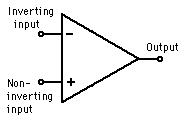Operational Amplifiers
The term operational amplifier or "op-amp" refers to a class of high-gain DC coupled amplifiers with two inputs and a single output. The modern integrated circuit version is typified by the famous 741 op-amp. Some of the general characteristics of the IC version are:
|
 |
Their characteristics often approach that of the ideal op-amp and can be understood with the help of the golden rules.
Electronics concepts
Op-amp concepts
| HyperPhysics*****Electricity and magnetism | R Nave |
